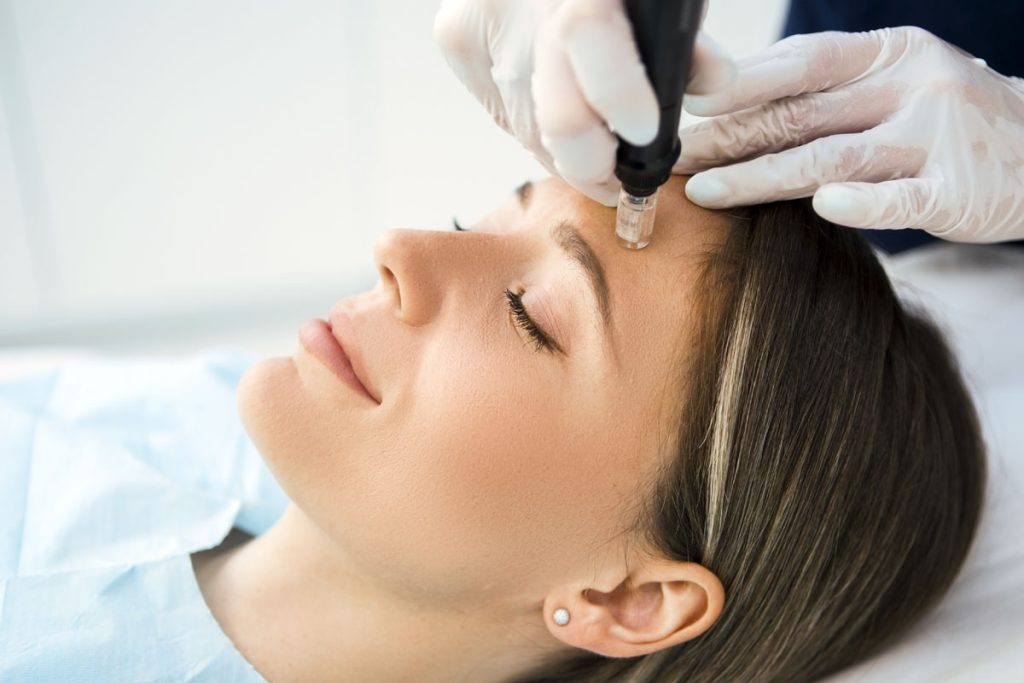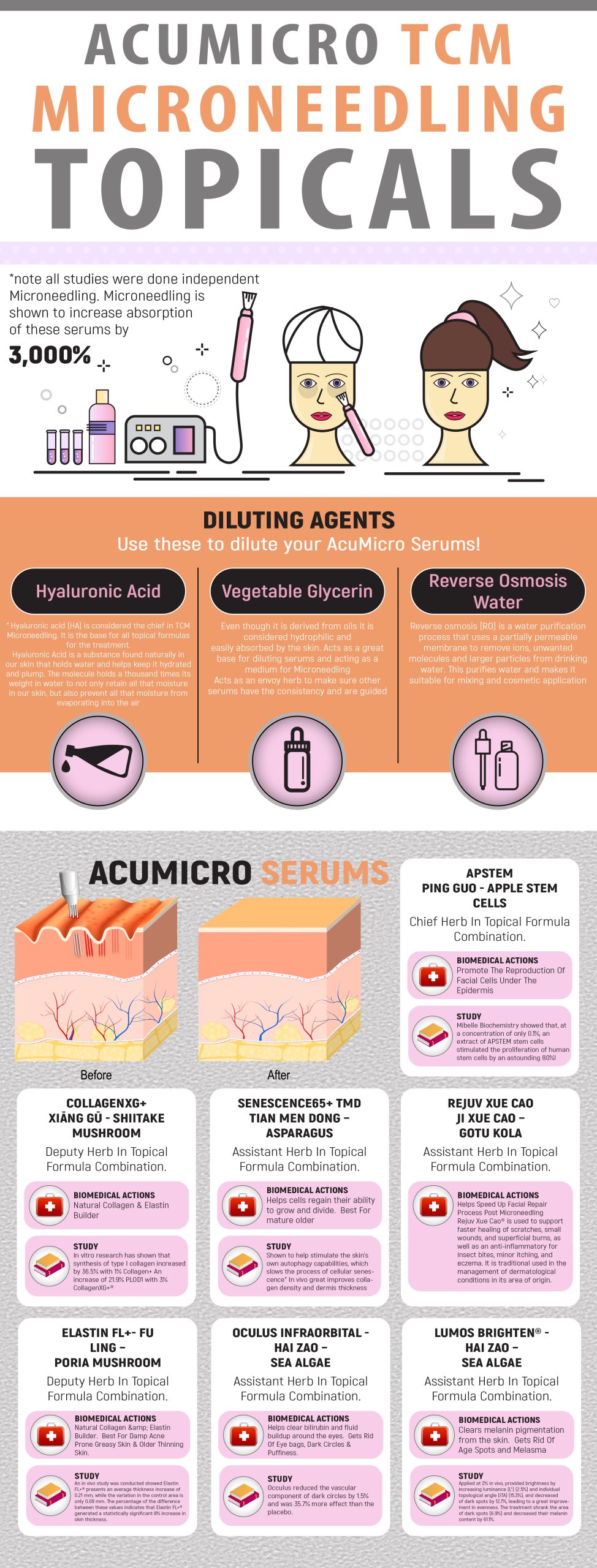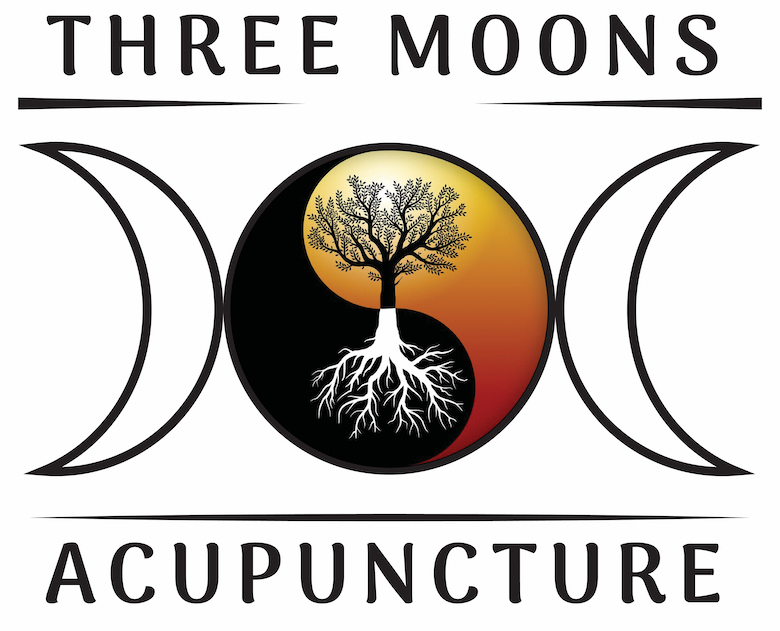Typical Treatment
- May include a facial prep with 4% numbing cream, (the treatment is very shallow, gentle & generally painless).
- Cleanse face of numbing cream and makeup
- Apply Hyaluronic Acid to skin to act as a gliding gel for the micro-needling device and to increase hydration of skin.
- Micro-needle or Nano-needle the entire face and neck (Décolletage add-ons available).
- After micro/nano-needling, an Aloe Face Mask will be placed for 10 minutes, and a customized Chinese Botanical Serum will be applied to the skin.
- Patient is sent home with Topical Hyaluronic Acid & TCM serum to apply throughout the rest of that day.
- Red light therapy may be used after your treatment to enhance collagen production (20 minutes add-on option available)
Total Treatment Time: 45 to 60 minutes.
What Is Microneedling?
Simply put, Micro-Needling is the insertion of very fine short needles into the skin for the purpose of rejuvenation. The premise is simple – create a small wound and the skin will respond with collagen production and new skin cells. Depending on the depth of the needle penetration, this can offer skin rejuvenation levels from the simple enhancement of product absorption to the clinical treatment of scars and wrinkles.

Micro-Channels In The Skin
Micro-Needling creates micro channels in the skin. When those channels are created the skins own repair response is to start producing collagen and elastin, this is to heal that controlled injury that was just created. That in turn make our skin tighter and smoother.
Microneedling can be used in combination with Hyaluronic Acid and other serums to hydrate and heal the skin. The micro-channels created by the needles allow for deeper penetrations of topical serums for more effective results. This procedure can increase the skins ability to utilize the nutrients by up to 3,000 %.
What Is Nanoneedling?
Uses the same type of oscillating motion to treat the skin but the cartridge encompasses 81 silicone tips. These microscopic hair-like cones separate the cells within the epidermis to allow active products to be pushed into the skin. Nano-Needling only affects the epidermis, treating within the upper .15 mm of the skin. The benefits of this serum infusion treatment include pigmentation reduction, increased cell turnover, skin rejuvenation and an immediate glow with no downtime. This treatment can be done weekly to exfoliate the skin.
In the present, clinical evaluation of patients showed statistically significant overall improvement of post acne atrophic scars, skin texture and patient satisfaction in response to skin microneedling treatment compared to baseline. Skin microneedling therapy showed a favorable effect on enhancing collagen formation, increase of epidermal thickening and newly synthesized tropoelastin, the precursor to elastin. The statistically significant increase occurred three months after starting treatment.
BEFORE/DURING/AFTER
Please contact your doctor if you are unsure if microneedling is right for you
MICRONEEDLING TREATMENT INFORMATION
CONTRAINDICATIONS
- Pregnant or nursing
- Botox within 4 weeks
- Fillers within 4 weeks
- Accutane within 6 months
- Cardiac abnormalities
- Platelet abnormalities
- Local infection such as warts, herpes zoster or herpes simplex (cold sores)
- Active acne (based on individual cases)
- Moderate to severe chronic skin disease such as eczema and psoriasis
- Dermatological diseases affecting the face (i.e. Porphyria)
- Facial cancer, past and present
- Patient on chemo/radiotherapy
- Steroid therapy
- Blood clotting problems, Blood dyscrasias, patients on anticoagulant therapy (i.e.: Warfarin)
- Diabetes and other chronic conditions
- Extreme keloidal tendency
BEFORE TREATMENT
- No botox within 4 weeks
- No fillers within 4 weeks
- No accutane within 6 months
- No deep facial peels or other invasive facial procedures within 4 weeks
- No exfoliating or harsh facial treatments 2 weeks before or after treatment
- No makeup day of treatment
DURING TREATMENT
- Lidocaine may be an option if worried about sensitivity
- Microneedling and/or nanoneedling procedure will then be done on desired areas with specialized herbal serums to improve results (30 minutes)
- Microneedling is done at 0.5 mm to enhance results while decreasing discomfort (deeper depths used under certain circumstances)
- A cooling facial mask with aloe + herbs is applied after the treatment to jumpstart the healing process and decrease discomfort (10 minutes)
- An add-on option: red light therapy may be used after your treatment to enhance collagen production (20 minutes)
POST TREATMENT
- Skin will be pink or red and may feel warm, like mild sunburn, tight and itchy, which usually subside in 12 to 24 hrs
- Minor flaking or dryness of the skin, with scab formation in very rare cases.
- Crusting, discomfort, bruising and swelling may occur.
- Pinpoint bleeding.
- It is possible to have a cold sore flare if you have a history of outbreaks.
- Freckles may lighten temporarily or permanently disappear in treated areas.
- Facial products have a much higher absorption rate during the week after the treatment.
- It takes two weeks to see results of treatment.
- It takes 4 treatments to see full changes.
- No exfoliating or harsh facial treatments 2 weeks post microneedling
- No botox or fillers for 4 weeks post microneedling
- No deep facial peels for 4 weeks post microneedling
- No invasive facial procedures for 4 weeks post microneedling
AFTERCARE
- No exercise the day of the treatment
- Use aloe or recommended serum from Acupuncturists to reduce redness
- Stay out of the sun the day of treatment
- No makeup the day of treatment
- Use hyaluronic acid to moisturize the day of treatment
- Do not use facial soap the day of treatment
- You can resume your normal makeup routine the day AFTER the treatment

Research
- Fabbrocini G, Fardella N, Monfrecola A, Proietti I, Innocenzi D (2009) Acne scarring treatment using skin needling. Clin Exp Dermatol 34: 874-879.
- Fabbrocini G, Annunziata MC, D’Arco V, De Vita V, Lodi G, Mauriello MC, Pastore F, Monfrecola G (2010) Acne scars: Pathogenesis, classification, and treatment. Dermatol Res Pract 2010: 893080.
- Fife D (2011) Practical evaluation and management of atrophic acne scars. Tips for the general dermatologist. J Clin Aesthet Dermatol 4: 550-57.
- Goodman G (2003) Post acne scarring: a review. J Cosmet Laser Ther 5: 77-95.
- Goodman GJ, Baron JA (2006) Post acne scarring: a qualitative global scarring grading system. Dermatol Surg 32: 1458-1466.
- Jacob CI, Dover JS, Kaminer MS (2001) Acne scarring: a classification system and review of treatment options. J Am Acad Dermatol 45: 109-117.
- Leheta TM, Abdel Hay RM, Hegazy RA, El Garem YF (2012) Do combined alternating sessions of 1540 nm nonablative fractional laser and percutaneous collagen induction with trichloroacetic acid 20% show better results than each individual modality in the treatment of atrophic acne scars? A randomized controlled trial. J Dermatolog Treat epub ahead of print.
- Leheta TM, Abdel Hay RM, El Garem YF (2012) Deep peeling using phenol versus percutaneous collagen induction combined with trichloroacetic acid20 in atrophic post-acne scars: a randomized controlled trial. J Dermatology Treat epub ahead of print.
- Leheta T, El Tawdy A, Abdel Hay R, Farid S (2011) Percutaneous collagen induction versus full-concentration trichloroacetic acid in thetreatmentofatrophicacnescars. DermatolSurg37:207-216.
- Levy LL, Zeichner JA (2012) Management of acne scarring, Part II: A comparative review of non-laser based, minimally invasive approaches. Am J Clin Dermatol 13:331-340.
- Shah SK, Alexis AF (2010) Acne in skin of color: practical approaches to treatment. J Dermatolog Treat 21:206-2
Check out PubMed FOR MORE RESEARCH



